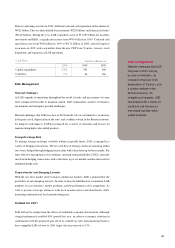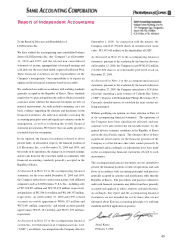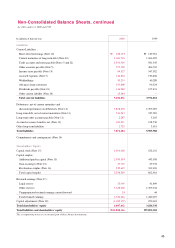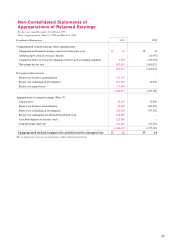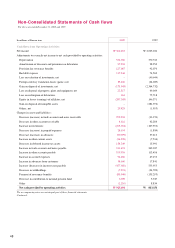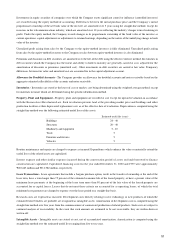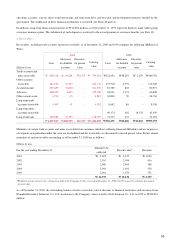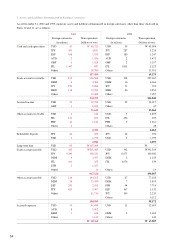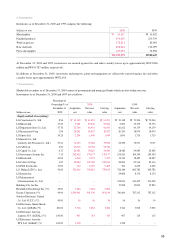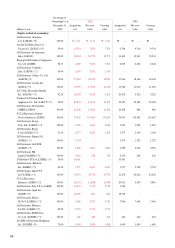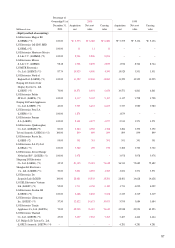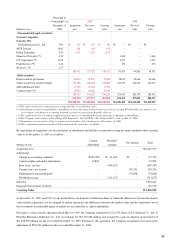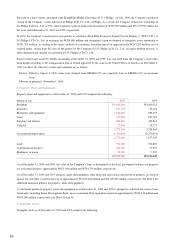LG 2000 Annual Report Download - page 50
Download and view the complete annual report
Please find page 50 of the 2000 LG annual report below. You can navigate through the pages in the report by either clicking on the pages listed below, or by using the keyword search tool below to find specific information within the annual report.1. The Company:
LG Electronics Inc. (the “Company”) was incorporated in 1959 under the Commercial Code of the Republic of Korea to
manufacture and sell electronic products. The Company is a member of the LG Group, which comprises affiliated companies under
common management direction. In 1970, the Company offered its shares for public ownership. As of December 31, 2000, the
Company has outstanding capital stock of W1,031,068 million, including non-voting preferred stock of W95,478 million and
redeemable preferred stock of W160,000 million (see Note 15). The Company’s common shares are listed on the Korean stock
exchange and its depositary receipts (“DRs”) are listed on the London and Luxembourg stock exchanges.
The Company entered into a merger agreement with LG Information & Communications, Ltd. (“LGIC”), an affiliate, which was in
the business of selling and manufacturing mobile telecommunication systems, mobile phones, electronic switching systems,
transmission equipment, network equipment and other related products, on June 8, 2000. The merger was approved at the
shareholders’ meeting on July 22, 2000. As a result, LGIC was merged into the Company effective September 1, 2000.
Pursuant to the resolution by the board of directors on November 27, 2000, the Company entered into a LOI (letter of intent)
regarding a joint venture of Cathode Ray Tubes (“CRT”) business with Koninklijke Philips Electronics N.V. (“Philips”). Currently,
detailed matters to establish the joint venture are being negotiated.
2. Summary of Significant Accounting Policies:
The significant accounting policies followed by the Company in the preparation of its financial statements are summarized below.
Basis of Financial Statement Presentation - The accompanying financial statements have been extracted from the Company’s
Korean language financial statements that were prepared using accounting principles, procedures and reporting practices generally
accepted in the Republic of Korea. These standards vary from International Accounting Standards and the accounting principles
generally accepted in the country of the reader. The financial statements have been translated from Korean into English, and have
been formatted in a manner different from the presentation under Korean financial statement practices. Certain supplementary
information included in the Korean language statutory financial statements, but not required for a fair presentation of the Company’s
financial position or results of operations, is not presented in the accompanying financial statements.
Accordingly, the accompanying financial statements are not intended to present the financial position, results of operations and cash
flows in accordance with accounting principles and practices generally accepted in countries and jurisdictions other than Korea.
The preparation of financial statements requires management to make estimates and assumptions that affect amounts reported
therein. Due to the inherent uncertainty involved in making estimates, actual results reported in future periods may differ from those
estimates.
Revenue Recognition - Sales of finished products and merchandise are recognized when delivered. Revenue from installation
service contracts is recognized using the percentage-of-completion method.
Marketable Securities and Investments in Debt and Equity Securities - All marketable securities and investments in equity and
debt securities are initially carried at cost determined by the weighted average method, including incidental expenses. In the case of
debt securities, cost includes the premium paid or discount received at the time of purchase. The following paragraphs describe the
subsequent accounting for securities by the type of security.
Marketable securities and investments in marketable equity securities of non-controlled investees are carried at fair value.
Temporary changes in fair value are recorded in current operations for marketable securities and accounted for in the capital
adjustment account, a component of shareholders’ equity, for investments in marketable equity securities.
Investments in non-marketable equity securities of non-controlled investees are carried at cost, except for declines in the Company’s
proportionate ownership of the underlying book value of the investee which are anticipated to be permanent, which are recorded in
current operations. Subsequent recoveries are also recorded in current operations up to the original cost of the investment.
50
Notes to Financial Statements
For the years ended December 31, 2000 and 1999



